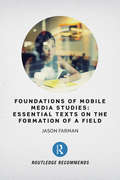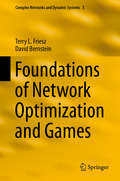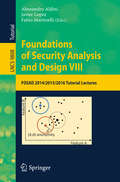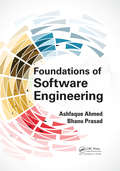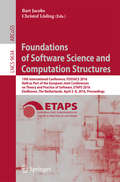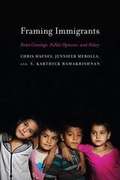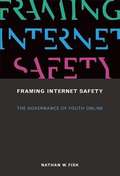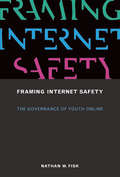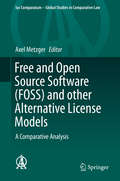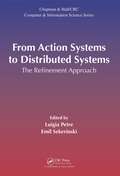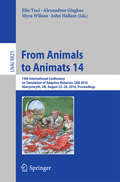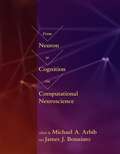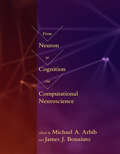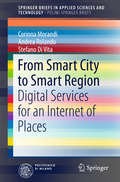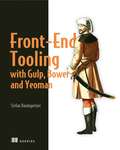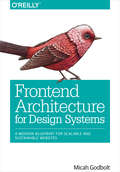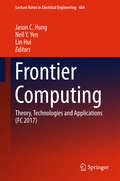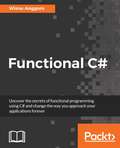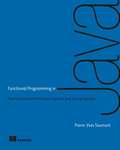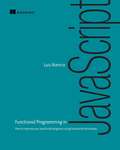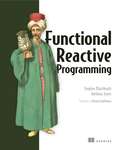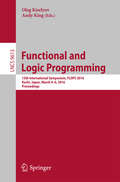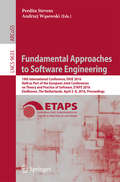- Table View
- List View
Foundations of Mobile Media Studies: Essential Texts on the Formation of a Field (Routledge Recommends)
by Jason FarmanFoundations of Mobile Media Studies gathers some of the most important texts in this emerging field, offering readers key approaches to understanding our moment and our media. The impact of mobile media is far reaching and this book discusses topics such as human intimacy, social space, political uprisings, labor, mobile phones in the developing world, gender, the mobile device’s impact on reading, mobile television, and mobile photography, among others. This carefully curated collection will serve as the central text to introduce this field to anyone eager to understand the rise of mobile technology, its impact on our relationships, and how these media have transformed the ways we understand the world around us.
Foundations of Network Optimization and Games
by David Bernstein Terry L. FrieszThis is a book about infrastructure networks that are intrinsically nonlinear. The networks considered range from vehicular networks to electric power networks to data networks. The main point of view taken is that of mathematical programming in concert with finite-dimensional variational inequality theory. The principle modeling perspectives are network optimization, the theory of Nash games, and mathematical programming with equilibrium constraints. Computational methods and novel mathematical formulations are emphasized. Among the numerical methods explored are network simplex, gradient projection, fixed-point, gap function, Lagrangian relaxation, Dantzig-Wolfe decomposition, simplicial decomposition, and computational intelligence algorithms. Many solved example problems are included that range from simple to quite challenging. Theoretical analyses of several models and algorithms, to uncover existence, uniqueness and convergence properties, are undertaken. The book is meant for use in advanced undergraduate as well as doctoral courses taught in civil engineering, industrial engineering, systems engineering, and operations research degree programs. At the same time, the book should be a useful resource for industrial and university researchers engaged in the mathematical modeling and numerical analyses of infrastructure networks.
Foundations of Security Analysis and Design VIII
by Alessandro Aldini Javier Lopez Fabio MartinelliFOSAD has been one of the foremost educational events established with the goal of disseminating knowledge in the critical area of security in computer systems and networks. Over the years, both the summer school and the book series have represented a reference point for graduate students and young researchers from academia and industry, interested to approach the field, investigate open problems, and follow priority lines of research. This book presents thoroughly revised versions of four tutorial lectures given by leading researchers during three International Schools on Foundations of Security Analysis and Design, FOSAD, held in Bertinoro, Italy, in September 2014, 2015 and 2016. The topics covered in this book include zero-knowledge proof systems, JavaScript sandboxing, assessment of privacy, and distributed authorization.
Foundations of Software Engineering
by Ashfaque Ahmed Bhanu PrasadThe best way to learn software engineering is by understanding its core and peripheral areas. Foundations of Software Engineering provides in-depth coverage of the areas of software engineering that are essential for becoming proficient in the field. The book devotes a complete chapter to each of the core areas. Several peripheral areas are also explained by assigning a separate chapter to each of them. Rather than using UML or other formal notations, the content in this book is explained in easy-to-understand language. Basic programming knowledge using an object-oriented language is helpful to understand the material in this book. The knowledge gained from this book can be readily used in other relevant courses or in real-world software development environments.This textbook educates students in software engineering principles. It covers almost all facets of software engineering, including requirement engineering, system specifications, system modeling, system architecture, system implementation, and system testing. Emphasizing practical issues, such as feasibility studies, this book explains how to add and develop software requirements to evolve software systems.This book was written after receiving feedback from several professors and software engineers. What resulted is a textbook on software engineering that not only covers the theory of software engineering but also presents real-world insights to aid students in proper implementation. Students learn key concepts through carefully explained and illustrated theories, as well as concrete examples and a complete case study using Java. Source code is also available on the book’s website. The examples and case studies increase in complexity as the book progresses to help students build a practical understanding of the required theories and applications.
Foundations of Software Science and Computation Structures
by Bart Jacobs Christof LödingThis book constitutes the proceedings of the 19thInternational Conference on Foundations of Software Science and ComputationStructures, FOSSACS 2016, which took place in Eindhoven, The Netherlands, inApril 2016, held as Part of the European Joint Conferences on Theory andPractice of Software, ETAPS 2016. The 31 full papers presented in this volume werecarefully reviewed and selected from 85 submissions. They were organized intopical sections named: types; recursion and fixed-points; verification andprogram analysis; automata, logic, games; probabilistic and timed systems;proof theory and lambda calculus; algorithms for infinite systems; and monads.
Fragments of an Infinite Memory: My Life with the Internet
by Mael RenouardA deeply informed, yet playful and ironic look at how the internet has changed human experience, memory, and our sense of self, and that belongs on the shelf with the best writings of Roland Barthes and Jean Baudrillard.&“One day, as I was daydreaming on the boulevard Beaumarchais, I had the idea—it came and went in a flash, almost in spite of myself—of Googling to find out what I&’d been up to and where I&’d been two evenings before, at five o&’clock, since I couldn&’t remember on my own.&” So begins Maël Renouard&’s Fragments of an Infinite Memory, a provocative and elegant inquiry into life in a wireless world. Renouard is old enough to remember life before the internet but young enough to have fully accommodated his life to the internet and the gadgets that support it. Here this young philosopher, novelist, and translator tries out a series of conjectures on how human experience, especially the sense of self, is being changed by our continual engagement with a memory that is impersonal and effectively boundless. Renouard has written a book that is rigorously impressionistic, deeply informed historically and culturally, but is also playful, ironic, personal, and formally adventurous, a book that withstands comparison to the best of Roland Barthes and Jean Baudrillard.
Framing Immigrants: News Coverage, Public Opinion, and Policy
by S. Karthick Ramakrishnan Chris Haynes Jennifer MerollaWhile undocumented immigration is controversial, the general public is largely unfamiliar with the particulars of immigration policy. Given that public opinion on the topic is malleable, to what extent do mass media shape the public debate on immigration? In Framing Immigrants, political scientists Chris Haynes, Jennifer Merolla, and Karthick Ramakrishnan explore how conservative, liberal, and mainstream news outlets frame and discuss undocumented immigrants. Drawing from original voter surveys, they show that how the media frames immigration has significant consequences for public opinion and has implications for the passage of new immigration policies. The authors analyze media coverage of several key immigration policy issues—including mass deportations, comprehensive immigration reform, and measures focused on immigrant children, such as the DREAM Act—to chart how news sources across the ideological spectrum produce specific “frames” for the immigration debate. In the past few years, liberal and mainstream outlets have tended to frame immigrants lacking legal status as “undocumented” (rather than “illegal”) and to approach the topic of legalization through human-interest stories, often mentioning children. Conservative outlets, on the other hand, tend to discuss legalization using impersonal statistics and invoking the rule of law. Yet, regardless of the media’s ideological positions, the authors’ surveys show that “negative” frames more strongly influence public support for different immigration policies than do positive frames. For instance, survey participants who were exposed to language portraying immigrants as law-breakers seeking “amnesty” tended to oppose legalization measures. At the same time, support for legalization was higher when participants were exposed to language referring to immigrants living in the United States for a decade or more. Framing Immigrants shows that despite heated debates on immigration across the political aisle, the general public has yet to form a consistent position on undocumented immigrants. By analyzing how the media influences public opinion, this book provides a valuable resource for immigration advocates, policymakers, and researchers.
Framing Internet Safety: The Governance of Youth Online
by Nathan W. FiskSince the beginning of the Internet era, it has become almost impossible to discuss youth and technology without mentioning online danger -- pornography that is just a click away, lurking sexual predators, and inescapable cyberbullies. In this book, Nathan Fisk takes an innovative approach to the subject, examining youth Internet safety as a technology of governance -- for information technologies and, by extension, for the forms of sociality and society they make possible. He argues that it is through the mobilization of various discourses of online risk that the everyday lives of youth are increasingly monitored and policed and the governing potentials of information technologies are explored. Fisk relates particular panics over youth Internet safety to patterns of technological adoption by young people, focusing on the policy response at the federal level aimed at producing future cybercitizens. He describes pedagogies of surveillance, which position parents as agents of surveillance; the evolution of the youth Internet safety curricula, as seen through materials on cyberbullying and online reputation management; and, drawing on survey results and focus groups, parent and child everyday practice. Finally, Fisk offers recommendations for a "cybersafety of everyday life," connecting youth Internet safety to trends in national infrastructure protection and corporate information assurance.
Framing Internet Safety: The Governance of Youth Online (The John D. and Catherine T. MacArthur Foundation Series on Digital Media and Learning)
by Nathan W. FiskAn examination of youth Internet safety as a technology of governance, seen in panics over online pornography, predators, bullying, and reputation management.Since the beginning of the Internet era, it has become almost impossible to discuss youth and technology without mentioning online danger—pornography that is just a click away, lurking sexual predators, and inescapable cyberbullies. In this book, Nathan Fisk takes an innovative approach to the subject, examining youth Internet safety as a technology of governance—for information technologies and, by extension, for the forms of sociality and society they make possible. He argues that it is through the mobilization of various discourses of online risk that the everyday lives of youth are increasingly monitored and policed and the governing potentials of information technologies are explored. Fisk relates particular panics over youth Internet safety to patterns of technological adoption by young people, focusing on the policy response at the federal level aimed at producing future cybercitizens. He describes pedagogies of surveillance, which position parents as agents of surveillance; the evolution of the youth Internet safety curricula, as seen through materials on cyberbullying and online reputation management; and, drawing on survey results and focus groups, parent and child everyday practice. Finally, Fisk offers recommendations for a “cybersafety of everyday life,” connecting youth Internet safety to trends in national infrastructure protection and corporate information assurance.
Free and Open Source Software (FOSS) and other Alternative License Models
by Axel MetzgerThis book discusses the main legal questions raised by free and open source software (FOSS) licenses and other alternative license models, such as Creative Commons. The legal questions raised by FOSS and other alternative licenses have been the subject of an intense international debate among legal scholars and practising lawyers in the last years. Courts in different jurisdictions have confirmed that the core features of FOSS licenses are compliant with the respective applicable laws and thus enforceable in the respective jurisdictions. What is still missing so far is an in-depth comparative analysis of the legal issues raised by FOSS, Creative Commons and other alternative license on a worldwide scale. This book presents a general report on FOSS licenses and alternative license models to establish common ground and enable comparison between jurisdictions. The general report is followed by 24 national reports covering the world's most important IT-markets. General and national reports use the same structure to facilitate the comparison. The book shows that despite the differences in their origins, all FOSS projects use detailed licenses for the organisation of their communities. It also shows the differences in the proofing of these licenses by courts in some jurisdictions and the tailor-made provisions established by some legislators to solve the legal issues raised by the license model.
From Action Systems to Distributed Systems: The Refinement Approach
by Emil Sekerinski Luigia PetreFormal methods traditionally address the question of transforming software engineering into a mature engineering discipline. This essentially refers to trusting that the software-intensive systems that form our society's infrastructures are behaving according to their specifications. More recently, formal methods are also used to understand propert
From Animals to Animats 14
by Elio Tuci Alexandros Giagkos Myra Wilson John HallamThis book constitutes the proceedings of the 14th International Conference on Simulation of Adaptive Behavior, SAB 2016, held in Aberystwyth, UK, in August 2016. The 31 papers presented in this volume were carefully reviewed and selected from 45 submissions. They cover the main areas in animat research, including the animat approach and methodology, perception and motor control, learning and adaptation, evolution, and collective and social behavior.
From Hacking to Report Writing
by Robert SvenssonLearn everything you need to know to become a professional security and penetration tester. It simplifies hands-on security and penetration testing by breaking down each step of the process so that finding vulnerabilities and misconfigurations becomes easy. The book explains how to methodically locate, exploit, and professionally report security weaknesses using techniques such as SQL-injection, denial-of-service attacks, and password hacking. Although From Hacking to Report Writing will give you the technical know-how needed to carry out advanced security tests, it also offers insight into crafting professional looking reports describing your work and how your customers can benefit from it. The book will give you the tools you need to clearly communicate the benefits of high-quality security and penetration testing to IT-management, executives and other stakeholders. Embedded in the book are a number of on-the-job stories that will give you a good understanding of how you can apply what you have learned to real-world situations. We live in a time where computer security is more important than ever. Staying one step ahead of hackers has never been a bigger challenge. From Hacking to Report Writing clarifies how you can sleep better at night knowing that your network has been thoroughly tested. What you'll learn Clearly understand why security and penetration testing is important Find vulnerabilities in any system using the same techniques as hackers do Write professional looking reports Know which security and penetration testing method to apply for any given situation Successfully hold together a security and penetration test project Who This Book Is For Aspiring security and penetration testers, security consultants, security and penetration testers, IT managers, and security researchers.
From Neuron to Cognition via Computational Neuroscience
by Michael A. Arbib James J. BonaiutoThis textbook presents a wide range of subjects in neuroscience from a computational perspective. It offers a comprehensive, integrated introduction to core topics, using computational tools to trace a path from neurons and circuits to behavior and cognition. Moreover, the chapters show how computational neuroscience -- methods for modeling the causal interactions underlying neural systems -- complements empirical research in advancing the understanding of brain and behavior. The chapters -- all by leaders in the field, and carefully integrated by the editors -- cover such subjects as action and motor control; neuroplasticity, neuromodulation, and reinforcement learning; vision; and language -- the core of human cognition.The book can be used for advanced undergraduate or graduate level courses. It presents all necessary background in neuroscience beyond basic facts about neurons and synapses and general ideas about the structure and function of the human brain. Students should be familiar with differential equations and probability theory, and be able to pick up the basics of programming in MATLAB and/or Python. Slides, exercises, and other ancillary materials are freely available online, and many of the models described in the chapters are documented in the brain operation database, BODB (which is also described in a book chapter).ContributorsMichael A. Arbib, Joseph Ayers, James Bednar, Andrej Bicanski, James J. Bonaiuto, Nicolas Brunel, Jean-Marie Cabelguen, Carmen Canavier, Angelo Cangelosi, Richard P. Cooper, Carlos R. Cortes, Nathaniel Daw, Paul Dean, Peter Ford Dominey, Pierre Enel, Jean-Marc Fellous, Stefano Fusi, Wulfram Gerstner, Frank Grasso, Jacqueline A. Griego, Ziad M. Hafed, Michael E. Hasselmo, Auke Ijspeert, Stephanie Jones, Daniel Kersten, Jeremie Knuesel, Owen Lewis, William W. Lytton, Tomaso Poggio, John Porrill, Tony J. Prescott, John Rinzel, Edmund Rolls, Jonathan Rubin, Nicolas Schweighofer, Mohamed A. Sherif, Malle A. Tagamets, Paul F. M. J. Verschure, Nathan Vierling-Claasen, Xiao-Jing Wang, Christopher Williams, Ransom Winder, Alan L. Yuille
From Neuron to Cognition via Computational Neuroscience (Computational Neuroscience Series)
by Michael A. Arbib James J. BonaiutoA comprehensive, integrated, and accessible textbook presenting core neuroscientific topics from a computational perspective, tracing a path from cells and circuits to behavior and cognition.This textbook presents a wide range of subjects in neuroscience from a computational perspective. It offers a comprehensive, integrated introduction to core topics, using computational tools to trace a path from neurons and circuits to behavior and cognition. Moreover, the chapters show how computational neuroscience—methods for modeling the causal interactions underlying neural systems—complements empirical research in advancing the understanding of brain and behavior. The chapters—all by leaders in the field, and carefully integrated by the editors—cover such subjects as action and motor control; neuroplasticity, neuromodulation, and reinforcement learning; vision; and language—the core of human cognition.The book can be used for advanced undergraduate or graduate level courses. It presents all necessary background in neuroscience beyond basic facts about neurons and synapses and general ideas about the structure and function of the human brain. Students should be familiar with differential equations and probability theory, and be able to pick up the basics of programming in MATLAB and/or Python. Slides, exercises, and other ancillary materials are freely available online, and many of the models described in the chapters are documented in the brain operation database, BODB (which is also described in a book chapter).ContributorsMichael A. Arbib, Joseph Ayers, James Bednar, Andrej Bicanski, James J. Bonaiuto, Nicolas Brunel, Jean-Marie Cabelguen, Carmen Canavier, Angelo Cangelosi, Richard P. Cooper, Carlos R. Cortes, Nathaniel Daw, Paul Dean, Peter Ford Dominey, Pierre Enel, Jean-Marc Fellous, Stefano Fusi, Wulfram Gerstner, Frank Grasso, Jacqueline A. Griego, Ziad M. Hafed, Michael E. Hasselmo, Auke Ijspeert, Stephanie Jones, Daniel Kersten, Jeremie Knuesel, Owen Lewis, William W. Lytton, Tomaso Poggio, John Porrill, Tony J. Prescott, John Rinzel, Edmund Rolls, Jonathan Rubin, Nicolas Schweighofer, Mohamed A. Sherif, Malle A. Tagamets, Paul F. M. J. Verschure, Nathan Vierling-Claasen, Xiao-Jing Wang, Christopher Williams, Ransom Winder, Alan L. Yuille
From Smart City to Smart Region
by Corinna Morandi Andrea Rolando Stefano Di VitaThis book offers a fascinating exploration of the relationship between information and communication technologies (ICTs) and spatial planning, expanding the concept of "urban smartness" from the usual scale of buildings or urban projects to the regional dimension. In particular, it presents the outcomes of research undertaken at Politecnico di Milano, in collaboration with Telecom Italia, that had three principal goals: to investigate the use of ICTs for the representation, promotion, management, and dissemination of an integrated system of services; to explore the spatial impacts of digital services at different scales (regional, urban, local); and to understand how a system of mobile services can encourage new spatial uses and new collective behavior in the quest for better spatial quality of places. Useful critical analysis of international case studies is also included with the aim of verifying the opportunities afforded by new digital services not only to improve the urban efficiency but also to foster the evolution of urban communities through enhancement of the public realm. The book will be a source of valuable insights for both scholars and local administrators and operators involved in smart city projects.
Front-End Tooling with Gulp, Bower, and Yeoman
by Stefan BaumgartnerSummaryFront-End Tooling with Gulp, Bower, and Yeoman teaches you how to use and combine these popular tools to set up a customized development workflow from start to finish.Purchase of the print book includes a free eBook in PDF, Kindle, and ePub formats from Manning Publications.About the TechnologyIn large web dev projects, productivity is all about workflow. Great workflow requires tools like Gulp, Bower, and Yeoman that can help you automate the design-build-deploy pipeline. Together, the Yeoman scaffolding tool, Bower dependency manager, and Gulp automation build system radically shorten the time it takes to release web applications.About the BookFront-End Tooling with Gulp, Bower, and Yeoman teaches you how to set up an automated development workflow. You'll start by understanding the big picture of the development process. Then, using patterns and examples, this in-depth book guides you through building a product delivery pipeline using Gulp, Bower, and Yeoman. When you're done, you'll have an intimate understanding of the web development process and the skills you need to create a powerful, customized workflow using these best-of-breed tools.What's InsideMastering web dev workflow patternsAutomating the product delivery pipelineCreating custom workflowsAbout the ReaderThis book is suitable for front-end developers with JavaScript experience.About the AuthorStefan Baumgartner has led front-end teams working across a wide range of development styles and application domains.Table of ContentsPART 1 - A MODERN WORKFLOW FOR WEB APPLICATIONSTooling in a modern front-end workflowGetting started with GulpA Gulp setup for local developmentDependency management with BowerScaffolding with YeomanPART 2 - INTEGRATING AND EXTENDING THE PLATFORMGulp for different environmentsWorking with streamsExtending GulpCreating modules and Bower componentsAdvanced Yeoman generators
Frontend Architecture for Design Systems: A Modern Blueprint for Scalable and Sustainable Websites
by Micah GodboltImagine what a large-scale web project would look like if frontend development were not treated as an add-on, but as an equal partner with backend development and content strategy. This practical book takes experienced web developers through the new discipline of frontend architecture, including the latest tools, standards, and best practices that have elevated frontend web development to an entirely new level.Using real-world examples, case studies, and practical tips and tricks throughout, author Micah Godbolt introduces you to the four pillars of frontend architecture. He also provides compelling arguments for developers who want to embrace the mantle of frontend architect and fight to make it a first-class citizen in their next project.The four pillars include:Code: how to approach the HTML, CSS, and JavaScript of a design systemProcess: tools and processes for creating an efficient and error-proof workflowTesting: creating a stable foundation on which to build your siteDocumentation: tools for writing documentation while the work is in progress
Frontier Computing: Theory, Technologies And Applications (Lecture Notes In Electrical Engineering #375)
by Neil Y. Yen Jason C. Hung Lin HuiThis book gathers the proceedings of the 6th International Conference on Frontier Computing, held in Osaka, Japan on July 12–14, 2017, and provides comprehensive coverage of the latest advances and trends in information technology, science and engineering. It addresses a number of broad themes, including communication networks, business intelligence and knowledge management, web intelligence, and related fields that inspire the development of information technology. The respective contributions cover a wide range of topics: database and data mining, networking and communications, web and internet of things, embedded systems, soft computing, social network analysis, security and privacy, optical communication, and ubiquitous/pervasive computing. Many of the papers outline promising future research directions, and the book will benefit students, researchers and professionals alike. Further, it offers a useful reference guide for newcomers to the field.
Functional C#
by Wisnu AnggoroUncover the secrets of functional programming using C# and change the way you approach your applications forever About This Book • This book focuses on the functional paradigm of C#, which will give you a whole new angle on coding with C# • It illustrates the advantages that functional programming brings to the table and the associated coding benefits • This practical guide covers all the aspects of functional programming and provides solutions that can be applied in business scenarios Who This Book Is For This book is suitable for C# developers with basic prior knowledge of C# and with no functional programming experience at all. What You Will Learn • Develop an application using the functional approach • Implement unit testing to functionally program code • Create efficient code using functional programming • Work through a LINQ query so you can work with data • Compose asynchronous programs to create a responsive application • Use recursion in function programming in order to simplify code • Optimize the program code using Laziness and Caching Techniques In Detail Functional programming makes your application faster, improves performance, and increases your productivity. C# code is written at a higher level of abstraction, so that code will be closer to business requirements, abstracting away many low-level implementation details. This book bridges the language gap for C# developers by showing you how to create and consume functional constructs in C#. We also bridge the domain gap by showing how functional constructs can be applied in business scenarios. We'll take you through lambda expressions and extension methods, and help you develop a deep understanding of the concepts and practices of LINQ and recursion in C#. By the end of the book, you will be able to write code using the best approach and will be able to perform unit testing in functional programming, changing how you write your applications and revolutionizing your projects. Style and approach This book takes a pragmatic approach and shows you techniques to write better functional constructs in C#. We'll also show you how these concepts can be applied in business scenarios.
Functional Programming in Java: How functional techniques improve your Java programs
by Pierre-Yves SaumontSummaryFunctional Programming in Java teaches Java developers how to incorporate the most powerful benefits of functional programming into new and existing Java code. You'll learn to think functionally about coding tasks in Java and use FP to make your applications easier to understand, optimize, maintain, and scale. Purchase of the print book includes a free eBook in PDF, Kindle, and ePub formats from Manning Publications.About the TechnologyHere's a bold statement: learn functional programming and you'll be a better Java developer. Fortunately, you don't have to master every aspect of FP to get a big payoff. If you take in a few core principles, you'll see an immediate boost in the scalability, readability, and maintainability of your code. And did we mention that you'll have fewer bugs? Let's get started!About the BookFunctional Programming in Java teaches you how to incorporate the powerful benefits of functional programming into new and existing Java code. This book uses easy-to-grasp examples, exercises, and illustrations to teach core FP principles such as referential transparency, immutability, persistence, and laziness. Along the way, you'll discover which of the new functionally inspired features of Java 8 will help you most.What's InsideWriting code that's easier to read and reason aboutSafer concurrent and parallel programmingHandling errors without exceptionsJava 8 features like lambdas, method references, and functional interfacesAbout the ReaderWritten for Java developers with no previous FP experience.About the AuthorPierre-Yves Saumont is a seasoned Java developer with three decades of experience designing and building enterprise software. He is an R&D engineer at Alcatel-Lucent Submarine Networks.Table of ContentsWhat is functional programming? Using functions in Java Making Java more functional Recursion, corecursion, and memoization Data handling with lists Dealing with optional data Handling errors and exceptions Advanced list handling Working with laziness More data handling with trees Solving real problems with advanced trees Handling state mutation in a functional wayFunctional input/output Sharing mutable state with actors Solving common problems functionally
Functional Programming in JavaScript: How to improve your JavaScript programs using functional techniques
by Luis AtencioSummaryFunctional Programming in JavaScript teaches JavaScript developers functional techniques that will improve extensibility, modularity, reusability, testability, and performance. Through concrete examples and jargon-free explanations, this book teaches you how to apply functional programming to real-life development tasksPurchase of the print book includes a free eBook in PDF, Kindle, and ePub formats from Manning Publications.About the TechnologyIn complex web applications, the low-level details of your JavaScript code can obscure the workings of the system as a whole. As a coding style, functional programming (FP) promotes loosely coupled relationships among the components of your application, making the big picture easier to design, communicate, and maintain.About the BookFunctional Programming in JavaScript teaches you techniques to improve your web applications - their extensibility, modularity, reusability, and testability, as well as their performance. This easy-to-read book uses concrete examples and clear explanations to show you how to use functional programming in real life. If you're new to functional programming, you'll appreciate this guide's many insightful comparisons to imperative or object-oriented programming that help you understand functional design. By the end, you'll think about application design in a fresh new way, and you may even grow to appreciate monads!What's InsideHigh-value FP techniques for real-world usesUsing FP where it makes the most senseSeparating the logic of your system from implementation detailsFP-style error handling, testing, and debuggingAll code samples use JavaScript ES6 (ES 2015)About the ReaderWritten for developers with a solid grasp of JavaScript fundamentals and web application design.About the AuthorLuis Atencio is a software engineer and architect building enterprise applications in Java, PHP, and JavaScript.Table of ContentsPART 1 THINK FUNCTIONALLYBecoming functional Higher-order JavaScript PART 2 GET FUNCTIONALFew data structures, many operations Toward modular, reusable code Design patterns against complexityPART 3 ENHANCING YOUR FUNCTIONAL SKILLSBulletproofing your codeFunctional optimizations Managing asynchronous events and data
Functional Reactive Programming
by Stephen BlackheathSummaryFunctional Reactive Programming teaches the concepts and applications of FRP. It offers a careful walk-through of core FRP operations and introduces the concepts and techniques you'll need to use FRP in any language.Purchase of the print book includes a free eBook in PDF, Kindle, and ePub formats from Manning Publications.About the TechnologyToday's software is shifting to more asynchronous, event-based solutions. For decades, the Observer pattern has been the go-to event infrastructure, but it is known to be bug-prone. Functional reactive programming (FRP) replaces Observer, radically improving the quality of event-based code.About the BookFunctional Reactive Programming teaches you how FRP works and how to use it. You'll begin by gaining an understanding of what FRP is and why it's so powerful. Then, you'll work through greenfield and legacy code as you learn to apply FRP to practical use cases. You'll find examples in this book from many application domains using both Java and JavaScript. When you're finished, you'll be able to use the FRP approach in the systems you build and spend less time fixing problems. What's InsideThink differently about data and eventsFRP techniques for Java and JavaScriptEliminate Observer one listener at a timeExplore Sodium, RxJS, and Kefir.js FRP systemsAbout the ReaderReaders need intermediate Java or JavaScript skills. No experience with functional programming or FRP required.About the AuthorsStephen Blackheath and Anthony Jones are experienced software developers and the creators of the Sodium FRP library for multiple languages. Foreword by Heinrich Apfelmus. Illustrated by Duncan Hill.Table of ContentsStop listening! Core FRP Some everyday widget stuff Writing a real application New concepts FRP on the web Switch Operational primitives Continuous time Battle of the paradigms Programming in the real world Helpers and patterns Refactoring Adding FRP to existing projects Future directions
Functional and Logic Programming
by Andy King Oleg KiselyovThis bookconstitutes the proceedings of the 13th International Symposium on Functionaland Logic Programming, FLOPS 2016, held in Kochi, Japan, in March 2016. The 14 papers presented in this volume were carefully reviewed and selectedfrom 36 submissions. They cover the following topics: functional and logicprogramming; program transformation and re-writing; and extracting programsfrom proofs of their correctness.
Fundamental Approaches to Software Engineering
by Andrzej Wąsowski Perdita StevensThis bookconstitutes the proceedings of the 19th International Conference on FundamentalApproaches to Software Engineering, FASE 2016, which took place in Eindhoven,The Netherlands, in April 2016, held as Part of the European Joint Conferenceson Theory and Practice of Software, ETAPS 2016. The 23 full papers presented in this volume were carefully reviewed and selectedfrom 90 submissions. They were organized in topical sections named: concurrentand distributed systems; model-driven development; analysis and bug triaging;probabilistic and stochastic systems; proof and theorem proving; andverification.
